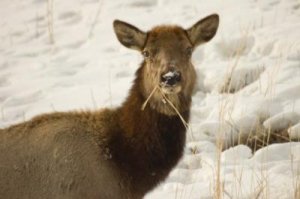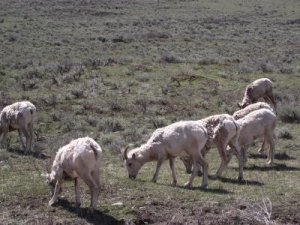EUGENE, Ore. -- (April 18, 2012) -- The feeding habits of mammals haven't always been what they are today, particularly for omnivores, finds a new study that appeared online this week ahead of regular publication in the Proceedings of the National Academy of Sciences.
 Samantha Hopkins, a professor in the University of Oregon's Clark Honors College and Department of Geological Sciences, was a co-lead author on the study.
Samantha Hopkins, a professor in the University of Oregon's Clark Honors College and Department of Geological Sciences, was a co-lead author on the study.
Some groups of mammals almost exclusively eat meat — take lions and tigers and other big cats, for example. Other mammals such as deer, cows and antelope are predominantly plant-eaters, living on a diet of leaves, shoots, fruits and bark. But particularly for omnivores that live on plant foods in addition to meat, the situation wasn't always that way, finds a new study by researchers working at the National Evolutionary Synthesis Center in Durham, N.C.
The center is a collaborative center shared by Duke University, North Carolina State University and the University of North Carolina at Chapel Hill.
Past studies have shown that animals with similar diets tend to share certain characteristics. But this study is the first of its kind to look across all mammal groups, including omnivores, to reconstruct how mammal diets have changed over evolutionary time.
 To do that, the researchers compiled previously published diet data for more than 1,500 species representing more than one third of mammals alive today, including primates, ungulates, bats, rabbits and rodents. By mapping that data onto the mammal family tree, the researchers were able to trace backwards in time and infer what the ancestors of each species most likely ate.
To do that, the researchers compiled previously published diet data for more than 1,500 species representing more than one third of mammals alive today, including primates, ungulates, bats, rabbits and rodents. By mapping that data onto the mammal family tree, the researchers were able to trace backwards in time and infer what the ancestors of each species most likely ate.
They found that while some mammals maintained steady diets, others changed their feeding strategies over time.
Today's omnivores in particular — a group that includes primates, bears, dogs and foxes — came from ancestors that primarily ate plants, or animals, but not both, said co-author Samantha Price of the University of California, Davis.
 While omnivorous mammals weren't always that way, plant-eaters and meat-eaters have diversified within a more well-worn path. Radical shifts were unlikely for these animals. Mammals that eat meat for a living, for example, never gave up their taste for flesh without transitioning through an omnivorous stage first.
While omnivorous mammals weren't always that way, plant-eaters and meat-eaters have diversified within a more well-worn path. Radical shifts were unlikely for these animals. Mammals that eat meat for a living, for example, never gave up their taste for flesh without transitioning through an omnivorous stage first.
"Direct transitions from carnivory to herbivory were essentially nonexistent," said co-author Louise Roth of Duke University. "It's an intuitive result because it takes very different kinds of equipment to have those kinds of diets," she added.
 "Plant- and animal-based foods require different digestive chemistries and different processing mechanisms in the mouth and stomach," said the UO's Hopkins, a mammal evolutionary ecologist who worked closely with Price on data collection and analyses.
"Plant- and animal-based foods require different digestive chemistries and different processing mechanisms in the mouth and stomach," said the UO's Hopkins, a mammal evolutionary ecologist who worked closely with Price on data collection and analyses.
The kinds of teeth adapted for tearing and slicing meat, for example, are remarkably different from the large, flat-topped molars adapted for grinding nuts and roots, Hopkins said.
Given these differences, Price said, "it makes sense that you couldn't easily transition from one to the other in one step."
The researchers found that diet is also linked to how fast mammals spawn new species. As new species arise and others go extinct, on balance the plant-eaters proliferate faster than their meat-eating counterparts, with omnivores lagging behind both groups.
"If there was an evolutionary race to evolve 100 species, it would take three times longer for omnivores compared to herbivores, and carnivores would be in the middle," Price said.
Co-authors with Price, Hopkins and Roth was Kathleen K. Smith, a biologist at Duke University. The National Science Foundation supported the research through postdoctoral fellowship and short-term visitor grants Hopkins and Price through the National Evolutionary Synthesis Center.
(This story was adapted from an original news release issued by Robin Ann Smith, a writer at the National Evolutionary Synthesis Center.)